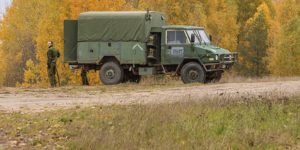By Steven Fouchard
Gatineau, Quebec — The motto of the Canadian Armed Forces (CAF) Logistics Branch, which plays a wide range of supportive roles from transporting equipment and troops to providing command and control functions, is Servitium Nulli Secundus, meaning Service Second to None.
A process to refresh the CAF’s fleet of logistics vehicles is currently underway and has been designed to ensure the branch will continue to live up to that standard.
The Logistics Vehicle Modernization (LVM) Project, explained project director Maj. Michael Chagnon is about upgrading an aging fleet of vehicles but has also been designed with an eye to greater efficiency.
The project will mainly replace the Light Support and Heavy Logistics Vehicle Wheeled fleets (LSVW and HLVW) with new light (2.2 to 3.5 tonnes) and heavy (16.5+ tonnes) trucks, tractors, trailers, (45+ tonnes) kitted truck bodies (special equipment vehicle kits), integrated bulk material handling systems, bulk fuel, and water containers.
Request for proposals are expected to commence in 2019 and final delivery is scheduled for 2025. The initial cost estimate for the project is $500 million to $1.5 billion.

While the project is still in the early stages, and delivery of any new vehicles not expected before 2021, Chagnon said an analysis of what the CAF needs and what is available on the market has been done. The result is a general determination that the new vehicles will be heavier and have greater cargo capacities than what is currently in use.
“It comes down to how much we want to take out in the field and reducing the number of vehicles in the field as well,” said Chagnon. “So if you have one vehicle that can carry twice as much, then you only have one vehicle on the road as opposed to two. The entire fleet will revolutionize the way that logistics are done in terms of the ability to lift and move.”
The increased cargo capacity of the incoming light and heavy vehicles is demonstrated by their ability to carry, respectively, three-metre and six-metre cargo containers. Each vehicle will also be able to tow additional containers on trailers at the same time.
Modules that will be delivered with the new vehicles, meanwhile, will allow for a wide variety of additional uses.
“Having the modularity will allow a commander to switch amongst priorities if he needs to have more command posts or more workshops, or to carry supplies for example,” said Chagnon.
Canadian Armed Forces members board a Heavy Utility Truck Wheeled (HLVW) at Adazi Military Training Area in Kadaga, Latvia in September 2015 during Operation Reassurance. The Canadian Army’s HLVW fleet is set for replacement by new vehicles with greater cargo capacity and more flexibility. Photo by: Corporal Nathan
The Canadian Army is taking the lead with LVM, he added, because it is the most logistics-intensive of the CAF’s branches and will use 70 per cent of the new vehicles that will be ordered.
Logistics vehicles are classed according to their weight and cargo capacity as light, medium, or heavy. The vehicles that comprise the current logistics fleet are described below.
| Vehicle | Description |
| Light Support Vehicle Wheeled (LSVW) | A 4×4 truck powered by a 4 cylinder, 2.5-litre turbocharged diesel engine |
| Medium Logistics Vehicle Wheeled (MLVW) | A 6.3-ton, 6×6 general utility truck with roof racks for additional cargo capacity, used to transport troops, equipment, and tow artillery pieces |
| Heavy Logistics Vehicle Wheeled (HLVW) | A 6×6 truck able to carry up to 16 tons and tow an additional 15 tons of cargo on a trailer |
| Heavy Engineering Support Vehicle (HESV) | A15-ton vehicle, the 410-horsepower HESV can carry its own weight in cargo. Variants include a basic commercial dump truck and a tractor truck for hauling semi-trailers |
The LVM project is focused on replacing the light and heavy fleets only.
The CAF’s medium-class logistical vehicles will be replaced sooner in a separate but related process, the Medium Support Vehicle System (MSVS) Project. After a competitive bidding process, U.S.-based Mack Defense was selected as the supplier in 2015. The company, based in Allentown, Pennsylvania, will start delivery of more than 1,500 8×8 trucks in 2017 to replace the Medium Logistics Vehicle Wheeled (MLVW), a general utility truck used to transport troops and equipment and tow artillery.
The new medium vehicles are based on French manufacturer Renault’s Kerax line of logistics trucks. Final assembly will take place in Sainte-Claire, Quebec. With a capacity of 10 tons compared to the MLVW’s three-and-a-half, they will come in several variants, including mobile repair and cargo models.
Procuring weapons and vehicles for the Canadian Armed Forces is a long and detailed process. This is to ensure that military members are well-equipped and well-protected so they can effectively serve Canadians at home and abroad. Every measure is taken to make sure taxpayers get the best value for their money. The project described in this article is in the Options Analysis phase. Learn more about the Defence Equipment Acquisition Process and its phases here.
Steven Fouchard is a member of the Army Public Affairs Office